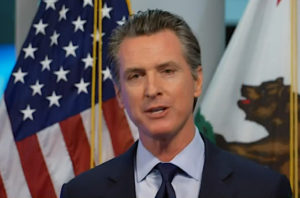Moving along into Phase 2 of California recovering from COVID-19, Gov. Gavin Newsom released the Cal/OSHA statewide general guidelines for the reopening of dine-in restaurants at his daily news conference on May 12 and — coming from a restaurant background himself, he admitted — it’s going to be a challenge.
The three-page checklist includes five categories, ranging from a bevy of physical distancing guidelines to employee training.
Restaurants will be required to create a written worksite specific plan; one person will be responsible for training and communication with employees and employee representatives on the plan, as well as developing a process to investigate any cases of COVID-19, alert the local health department, and identify and isolate close workplace contacts of infected employees until they are tested.

Gov. Gavin Newsom
There must be employee training on COVID-19, individual control measures, and screening which include symptom screenings and temperature checks.
The checklist also updated cleaning and disinfecting protocols. Some examples include: providing time for workers to implement cleaning practices during shifts and consider third-party cleaning companies; installing hands-free devices if possible; considering upgrades to improve air filtration and ventilation; offering disposable or digital menus; and table settings (napkins, cutlery, glassware, etc.) and shared condiments for customers only as needed, or supplying single-serve containers and having customer pack their own leftovers.
Physical distancing guidelines will prioritize outdoor seating and curbside pickup, asking customers to wait in their cars away from the establishment and alerting them that their table is ready through their mobile phones while avoiding the use of buzzers. Measures should be implemented to physically separate workers and customers by at least six feet, whether by reconfiguring space or installing physical partitions or visual cues to indicate to where workers should stand.
Restaurants should also reconfigure, restrict or close common areas like employee break rooms, provide alternative where physical distancing can be practiced, and discourage employees from congregating in high traffic areas. Similarly, physical distancing should be maintained in kitchen areas where practical; if not, the state recommends staggering shifts if possible to do work ahead of time. Other guidelines include closing bar areas, screening guests for symptoms, limiting the number of patrons at a single table and mandatory face coverings for any employees who must be within six feet of customers. And bad news for sushi bars and other counters — diners must be seated six feet away from employee work and food and drink preparation areas.
“Having been in the industry and having both opened and closed restaurants, it’s one of the most challenging and competitive businesses out there,” the governor and former busboy said at Tuesday’s conference. “That industry is particularly challenging. The rents are high, the fixed costs are extraordinarily high. I’m not naive about any of this, it’s going to be very trying.”
California Restaurant Assn. President and CEO Jot Condie released the following statement in response to the guidelines:
“After nearly two months of closure, every restaurant owner in California is reaching a critical phase in their ability to survive. Each day that passes without opening increases the risk of permanent closure. Today’s announcement gives us more clarity on what reopening looks like. We are grateful to the governor for recognizing how important local agencies are to the reopening of restaurants in thousands of neighborhoods all over California. Other states have established arbitrary rules around restaurant capacity, but what’s important are safety measures and physical distancing. Our own recommendations, which were the result of a collaboration with health officials, also recognize that local health agencies are best positioned to make these determinations in their own regions.”
Because COVID-19 conditions differ in counties across the state from rural Northern California to a more dense Los Angeles, reopening dates are fluid.
“It’s great to have some guidelines so that we can begin planning for when we finally are allowed to open up,” Redbird and Vibiana chef and owner Neal Fraser tells Irvine Weekly. “In the meantime, we will continue serving our community through takeout and cooking for those that are most vulnerable.”
Here’s the complete list of guidelines.
Advertising disclosure: We may receive compensation for some of the links in our stories. Thank you for supporting Irvine Weekly and our advertisers.

